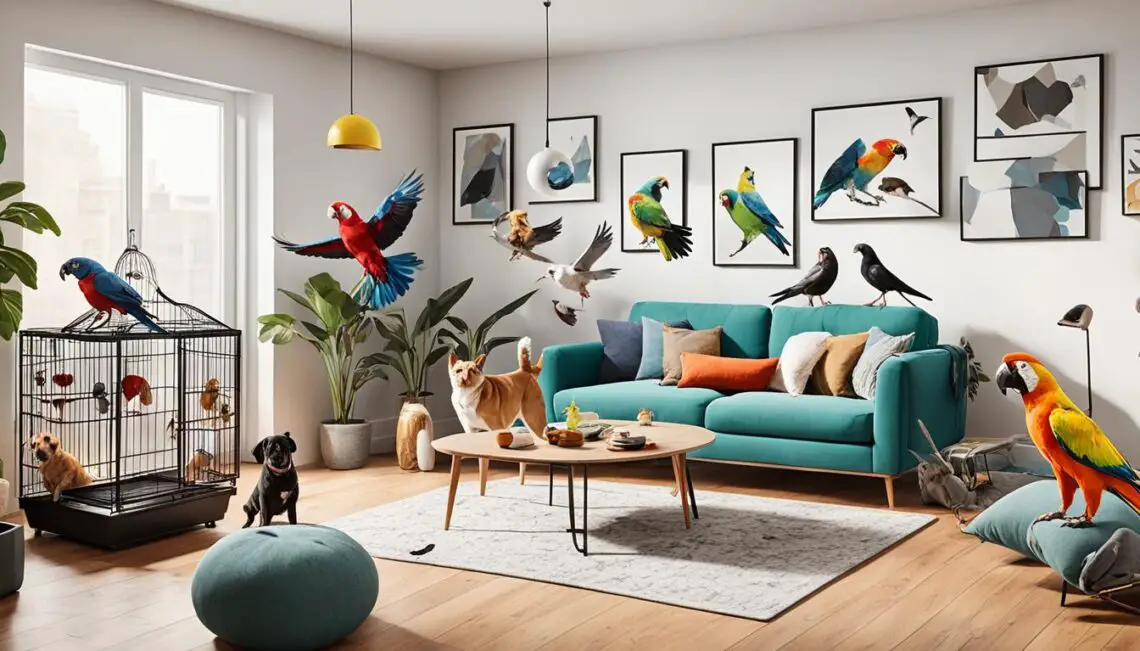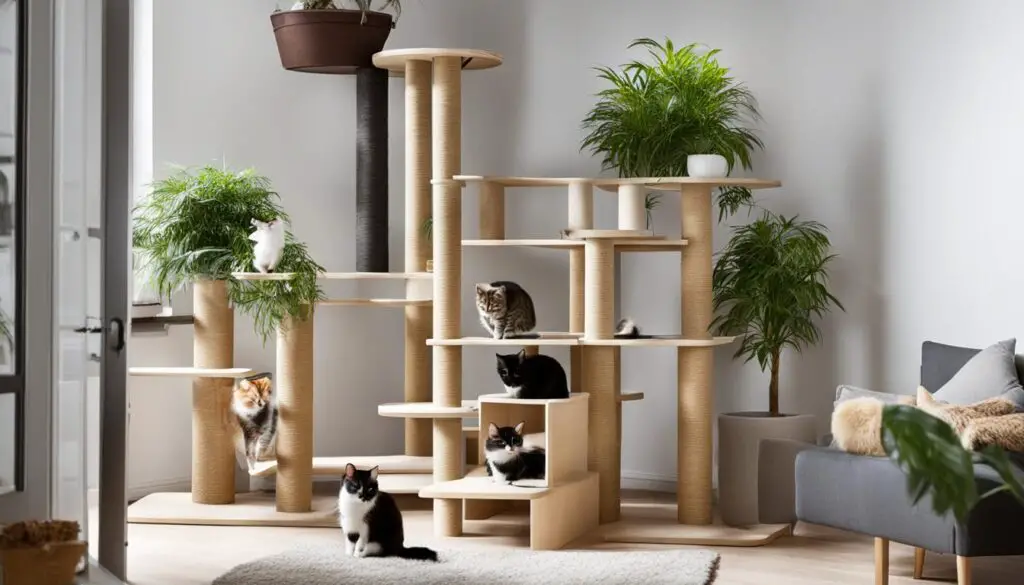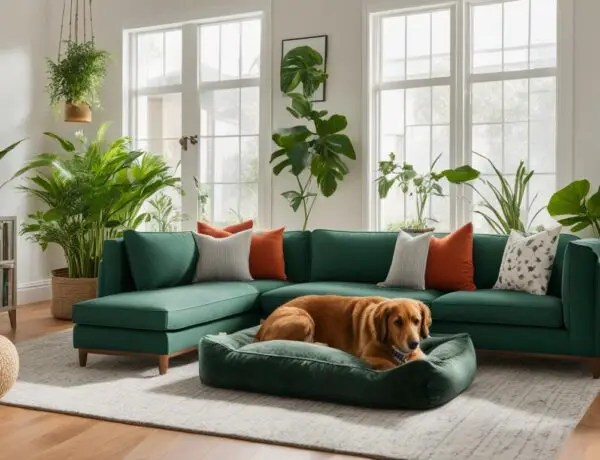Greetings dear readers, I’m here today to delve into the world of multi-pet households. As a pet lover myself, I understand the joys and challenges of sharing a home with multiple furry companions. Maintaining harmony and creating a peaceful environment for all pets to thrive is essential for a happy home.
Multi-pet households bring unique challenges, from territorial disputes to behavioral issues. But fear not, with a little knowledge and effort, you can navigate these challenges and foster a loving and harmonious home for your beloved pets.
Key Takeaways:
- Cats have unique territorial needs in multi-cat households.
- Providing enough resources like litter boxes, food and water stations, and scratching surfaces is crucial for harmony.
- Maximizing vertical space with perches or cat trees can enhance your pets’ environment.
- Regular exercise and interactive play sessions promote bonding and prevent aggression.
- Health problems can cause behavior issues, so regular vet check-ups are important.
Provide Plenty of Resources
When it comes to creating a harmonious multi-pet household, providing ample resources is essential. Cats have their individual preferences and needs, and ensuring they have access to the right resources can help prevent conflicts and promote a peaceful coexistence.
Litter Boxes for a Stress-Free Environment
One of the most important resources for cats in a multi-pet household is a litter box. Cats are meticulous about their bathroom habits and prefer having their personal space for elimination. To avoid litter box aversion and aggression, it’s crucial to have at least one litter box for each cat, plus an extra. This allows them to have their own designated areas, reducing competition and stress. Placing the litter boxes in separate locations throughout the house ensures easy accessibility for all cats.
Food and Water Stations for Peaceful Meal Times
When it comes to meal times, cats can be territorial. To avoid guarding behaviors and promote a relaxed eating environment, it’s important to have more than one food and water station. This allows all cats to eat and drink comfortably without feeling the need to defend their resources. Having multiple feeding areas also ensures that no cat goes hungry or is deprived of water.
Scratching Surfaces to Keep Everyone Happy
Scratching is a natural behavior for cats and serves many purposes, including marking territory, stretching, and keeping their claws healthy. To prevent furniture destruction and promote healthy scratching behaviors, it’s crucial to provide cats with several scratching surfaces. These should include both horizontal and vertical options made from different materials like sisal, cardboard, or carpet. Having a variety of scratching surfaces allows each cat to find their preferred spot and reduces the likelihood of conflicts over limited resources.
Hiding Spaces and Toys for Individual Comfort
Cats value their personal space and having designated hiding areas where they can retreat to can be a comforting resource. Providing hiding spaces, such as cozy cat caves or elevated perches, gives cats the opportunity to have some alone time and feel secure in their environment. Additionally, toys play an essential role in keeping cats mentally stimulated and physically active. Each cat should have access to a range of toys to satisfy their individual preferences and prevent boredom.
With ample resources, each cat in a multi-pet household can feel content and have their needs met. From litter boxes and food stations to scratching surfaces and hiding spaces, ensuring a well-equipped environment encourages harmony and reduces the likelihood of conflicts.
| Resources | Number Needed |
|---|---|
| Litter Boxes | 1 per cat + 1 extra |
| Food and Water Stations | More than 1 |
| Scratching Surfaces | Several, both horizontal and vertical |
| Hiding Spaces | Multiple |
| Toys | Varies per cat |
Maximize Vertical Space
Cats love climbing and feeling secure in their surroundings. By maximizing vertical space in your home, you can provide your feline friends with the opportunity to climb, explore, and observe their environment from high lookout points.
Accessible high places such as the top of furniture or shelves can be utilized to allow cats to exercise their natural instinct to climb. Cats feel safer when they have vertical spaces to retreat to and observe their surroundings.
Installing perches, ladders, or a cat tree can greatly enhance your cat’s climbing experiences and offer them more opportunities for exploration. These structures provide different levels and platforms for your cats to jump, climb, and perch on.
Make sure to provide at least one perch for every cat in your home. Placing perches near windows will not only maximize vertical space but also give your cats a view outside, which they often find stimulating and entertaining.
Benefits of Maximizing Vertical Space
- Physical Exercise: Climbing and exploring vertical spaces provide cats with valuable physical exercise, helping them to maintain a healthy weight and stay active.
- Mental Stimulation: Offering opportunities for climbing and perching fulfills cats’ natural instincts and provides mental enrichment.
- Territorial Expansion: Vertical spaces allow cats to establish territory and claim specific areas as their own, reducing potential conflicts with other pets.
- Privacy and Security: Cats feel safer when they have elevated perches where they can observe their surroundings and retreat to when they want privacy or feel threatened.
Tips for Maximized Vertical Space:
- Install cat perches at different heights to provide climbing opportunities for cats with varying abilities and preferences.
- Place vertical structures near windows to give your cats a view of the outside world and stimulate their curiosity.
- Ensure that perches are securely attached to prevent accidents or injuries.
- Regularly inspect vertical structures for wear and tear and replace or repair them as needed to maintain safety.
Make Exercise a Priority
Regular exercise is essential for keeping our feline friends healthy and happy. In a multi-cat household, it becomes even more important to ensure that each cat gets enough physical activity to prevent weight gain and promote their overall well-being.
Interactive play sessions are a great way to engage your cats in exercise while also fostering bonding between them. Set aside dedicated time each day to play with each cat individually, using toys that encourage movement and playfulness. This not only helps them burn off excess energy but also strengthens the bond between you and your furry companions.
When you’re away or busy, providing a variety of toys can keep your cats active and entertained. Interactive toys like puzzle feeders or treat-dispensing balls are excellent options to keep their minds and bodies engaged. These toys stimulate their natural hunting instincts and keep them mentally and physically stimulated, even in your absence.
“Interactive play sessions are a wonderful opportunity for cats to exhibit their natural predatory behavior and release pent-up energy. It’s a win-win situation for both their physical and emotional health.” – Veterinarian Dr. Emily Thompson
To promote exercise and prevent boredom, it’s essential to have a variety of toys that cater to different interests and preferences. Some cats may enjoy chasing toys on strings, while others may prefer batting at toys that resemble prey. Observe your cats’ behavior and preferences to choose toys that will keep them engaged and active.
In addition to physical health benefits, exercise plays a crucial role in maintaining harmony in a multi-cat household. Regular play sessions and physical activity can help alleviate stress, reduce aggression, and foster a positive environment where cats can coexist peacefully.
Remember, each cat has its own activity level and preferences, so it’s essential to tailor the exercise routine to suit their individual needs. Monitor their response to different toys and play styles to understand what they enjoy most.
By making exercise a priority and providing interactive play opportunities, you actively contribute to the physical and emotional well-being of your feline companions while also strengthening the bond among them.
Rule Out Health Problems
Sudden behavior changes in multi-cat households can be concerning and may indicate underlying health issues. Cats, like humans, can experience various health problems that can impact their behavior and overall well-being. If your cats are exhibiting aggression, litter box aversion, or other behavior changes, it’s essential to consider the possibility of health issues and take appropriate action. When it comes to the health of our feline friends, a trip to the vet’s office is necessary to rule out any underlying health problems and address any issues that arise.
Aggression in cats can sometimes stem from pain or discomfort caused by health problems. Cats may become aggressive as a way to protect themselves or cope with their discomfort. Similarly, litter box aversion can also be a sign of health issues such as urinary tract infections or digestive problems. By addressing these underlying health concerns, we can help our cats feel more comfortable and alleviate any potential aggression or litter box problems they may be experiencing.
Veterinary care is crucial in ensuring the well-being of our furry companions. Regular check-ups and assessments by a veterinarian can help identify any health issues early on and prevent them from escalating into more significant problems. It’s important to establish a relationship with a trusted veterinarian who can provide the necessary care and guidance for your multi-cat household.
“A trip to the vet’s office is necessary to rule out health problems and address any issues that arise.”
The Importance of Regular Veterinary Assessments
Cats’ behavior and health should be regularly assessed by a veterinarian. This is especially crucial in multi-cat households, where the dynamics between cats can influence their well-being. By monitoring their behavior, physical health, and any changes that occur, we can proactively address health issues and ensure a harmonious environment for all of our feline companions.
Veterinary assessments involve thorough examinations, medical history reviews, and discussions about any changes or concerns observed in the cats’ behavior. These assessments can provide invaluable insights into their overall health and help pinpoint any underlying health problems that may be contributing to behavior changes or aggression.
Regular veterinary assessments should include:
- Physical examinations to check for any signs of injury, pain, or discomfort
- Diagnostic tests, such as bloodwork and urinalysis, to detect any underlying health conditions
- Dental check-ups to maintain good oral health, as dental issues can also impact behavior
- Parasite prevention and vaccinations to protect against common diseases
By prioritizing regular veterinary care and assessments for our cats, we can ensure their well-being and address any health issues that may be causing behavior changes or aggression within our multi-cat households.
Cats All She Wrote
Maintaining peace and harmony in a multi-cat home is essential for creating a comfortable and happy environment for all feline friends. By providing enough resources and considering each cat’s individual needs, you can ensure a harmonious household.
Not all cats enjoy the company of other cats, and that’s perfectly normal. Some cats prefer solitude and may feel stressed or anxious when forced to live with other feline companions. It’s crucial to respect their preferences and create separate spaces where they can feel safe and secure.
Veterinary care plays a significant role in maintaining peace and harmony among your furry friends. Regular check-ups and assessments by a trusted veterinarian can help identify and address any behavior or health issues that may arise in a multi-cat household. Ensuring that all cats are in good health will contribute to a more peaceful and comfortable home environment.
By being mindful of your cats’ needs and making necessary changes, you can create a comfortable and harmonious living space for all of your feline companions. Remember to provide ample resources, consider individual preferences, and prioritize veterinary care for a peaceful and happy multi-cat home.
| Tips for a Peaceful Multi-Cat Home | |
|---|---|
| 1. Provide Adequate Resources | Ensure each cat has access to their own litter box, food and water station, scratching surfaces, hiding spaces, and toys. |
| 2. Respect Individual Preferences | Consider the personalities and preferences of your cats. Some may enjoy the company of other cats, while others may prefer solitude. |
| 3. Regular Veterinary Care | Schedule routine check-ups and assessments with a veterinarian to address any behavior or health issues in your multi-cat household. |
Survey Your Space and Money Matters
Before considering adding more pets to your household, it’s essential to evaluate your living quarters and financial situation. Ensuring that you have enough space and budget to comfortably accommodate multiple pets is crucial for their well-being and your peace of mind.
Assessing Your Space
Take a look around your home and determine if there’s enough room for each pet to have their own space. Consider factors such as the size of your living area, the number of existing pets, and the specific needs of each species.
If you already have multiple pets, it may be necessary to provide separate areas for each one. This includes multiple litter boxes, beds, and feeding stations. Giving each pet their own designated territory can help prevent conflicts and promote a more harmonious environment.
Budgeting for Pet Ownership
Pet ownership comes with financial responsibilities. When planning to have multiple pets, it’s important to consider the costs associated with their care. Some expenses to budget for include:
- Quality Food: Providing a nutritious diet is essential for the health and well-being of your pets. Investing in high-quality food can help prevent potential health issues in the long run.
- Veterinary Care: Regular check-ups, vaccinations, and preventive treatments are necessary to keep your pets healthy. With multiple pets, the cost of veterinary care can be higher, so it’s important to include these expenses in your budget.
- Additiona Costs: Depending on the type of pets you have, there may be additional expenses such as grooming, training, toys, and accessories. Planning for these costs in advance can help prevent any financial stress down the road.
Consulting with a veterinarian before adding more pets to your family is highly recommended. They can provide guidance on the challenges and additional costs you may encounter, as well as any specific considerations for the types of pets you’re interested in.
By carefully surveying your living space and budgeting for the costs of pet ownership, you can create a comfortable and happy environment for all your furry companions.
Conclusion
Navigating a multi-pet household requires careful consideration of each pet’s needs and providing adequate resources and attention. By creating harmony between pets, you can ensure a peaceful and loving home environment.
Introducing new pets gradually and respecting their individual preferences is key to fostering positive interactions. Monitoring their interactions and addressing any signs of aggression or discomfort promptly will help maintain a harmonious atmosphere.
Providing separate feeding areas for each pet and spending quality time with each one is essential. This ensures that every pet receives proper nutrition and individual attention, strengthening the bond between you and your furry companions.
While owning multiple pets comes with added responsibilities, it also brings endless rewards. The love and joy they bring to our lives are immeasurable. Embrace the journey of having a multi-pet household, and cherish the unconditional love and companionship they offer.
FAQ
Are cats social creatures?
Yes, cats are social creatures but have unique territorial needs in multi-cat households.
What behavioral issues can arise in multi-cat homes?
Behavioral issues in multi-cat homes can include fighting and eliminating outside the litter box.
How can I maintain harmony in a multi-cat household?
To maintain harmony, it’s crucial to provide enough resources like litter boxes, food and water stations, scratching surfaces, hiding spaces, and toys.
How can I maximize vertical space for my cats?
You can maximize vertical space by allowing cats to access high places and installing perches, ladders, or cat trees.
How can I prevent aggression and promote bonding between cats?
Regular exercise through interactive play sessions and providing toys for when you are away can help prevent aggression and promote bonding between cats.
Can health problems cause behavior issues in multi-cat households?
Yes, health problems can cause behavior issues in multi-cat households. It’s important to consult a vet if problems arise.
Do all cats enjoy the company of other cats?
No, not all cats enjoy the company of other cats. It’s essential to consider a cat’s personality before adding another furry family member.
How many litter boxes should I provide in a multi-cat household?
It’s recommended to provide at least one litter box for every cat, plus an extra, to prevent aggression and litter box aversion.
How many food and water stations should I have in a multi-cat household?
It’s advisable to have more than one food and water station to avoid guarding behaviors and allow all cats to eat and drink comfortably.
How many scratching surfaces should I provide in a multi-cat household?
Cats should have several scratching surfaces, both horizontal and vertical, made from different materials.
Should I provide hiding spaces and toys for each cat in a multi-cat household?
Yes, it’s important to provide hiding spaces and toys for each cat to enjoy and have their personal space.
How can I create more vertical space for my cats?
Cats love climbing and feel more secure when they can survey their surroundings from high lookout points. Installing perches, ladders, or cat trees can maximize vertical space and give cats more opportunities to climb and explore.
How many perches should I have in a multi-cat household?
It’s recommended to have at least one perch for every cat in the home and place them near windows for a view outside.
How can I promote physical health and prevent aggression among cats?
Many house cats are not as active as they should be, which can lead to weight gain and pent-up energy. Regular interactive play sessions with all cats promote their physical health and prevent aggression.
How can I keep my cats active and entertained when I am away?
Providing a variety of toys for cats to play with while you are away keeps them active and entertained.
Can playing together help cats bond and form stronger relationships?
Yes, playing together can help cats bond and form stronger relationships with each other.
What could sudden behavior changes in multi-cat households indicate?
Sudden behavior changes in multi-cat households may indicate underlying health issues.
Why do cats exhibit aggression or litter box aversion?
Cats may exhibit aggression or litter box aversion due to pain or discomfort.
Should I take my cats to the vet if behavior issues arise?
Yes, a trip to the vet’s office is necessary to rule out health problems and address any issues that arise.
How often should cats’ behavior and health be assessed by a veterinarian?
Cats’ behavior and health should be regularly assessed by a veterinarian.
What does maintaining peace and harmony in a multi-cat home require?
Maintaining peace and harmony in a multi-cat home requires providing enough resources and considering each cat’s individual needs.
Do all cats enjoy the company of other cats?
No, some cats may not enjoy the company of other cats, and it’s important to consider their preferences.
How can veterinary care help address behavior or health issues in a multi-cat household?
Veterinary care and assessments can help address any behavior or health issues in a multi-cat household.
How can I create a comfortable and peaceful home for my cats?
By being mindful of cats’ needs and making necessary changes, a comfortable and peaceful home can be maintained.
What should I consider before adding more pets to my home?
Before adding more pets, consider the available space in your home to ensure there’s enough room for everyone.
What additional resources may be needed in a multi-pet household?
Multiple litter boxes, beds, and separate areas may be needed in a multi-pet household.
How should I budget for multiple pets?
Budget for the costs of quality food, regular veterinary care, and additional expenses associated with multiple pets.
Should I consult with a vet before bringing in more pets?
Yes, it’s advisable to consult with a vet to understand the challenges and additional costs of supporting multiple pets.
What is important in navigating a multi-pet household?
Navigating a multi-pet household requires careful consideration of each pet’s needs and providing adequate resources and attention.
How can I create a peaceful home environment with multiple pets?
Creating harmony between pets involves introducing them gradually, respecting their individual preferences, and monitoring their interactions. Providing separate feeding areas and quality time for each pet is essential for maintaining a peaceful home environment.
What are the responsibilities and rewards of multiple pet ownership?
Multiple pet ownership comes with added responsibilities but also brings endless rewards and unconditional love.







No Comments